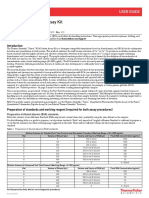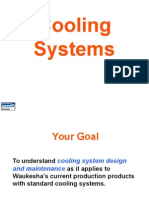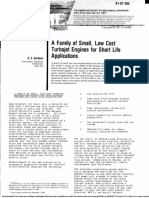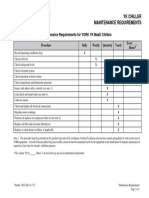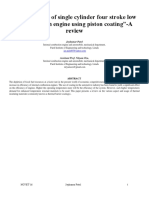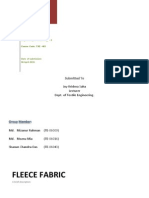Engine Cooling
Engine Cooling
Uploaded by
pradipCopyright:
Available Formats
Engine Cooling
Engine Cooling
Uploaded by
pradipOriginal Description:
Copyright
Available Formats
Share this document
Did you find this document useful?
Is this content inappropriate?
Copyright:
Available Formats
Engine Cooling
Engine Cooling
Uploaded by
pradipCopyright:
Available Formats
International Journal of Engineering Trends and Technology (IJETT) – Volume 36 Number 5- June 2016
Analysis of Causes of Engine Overheating due
to Cooling System Failure Using Pareto
Principle
Gurusaheb Singh Missan#1, Dr. I. P.Keswani*2
#
(Department of Industrial Engineering, Shri Ramdeobaba College of Engineering and Management Nagpur, India)
*
(Department of Industrial Engineering, Shri Ramdeobaba College of Engineering and Management Nagpur, India)
Abstract - Cooling system plays an important role to parts will burn and may result into seizing or welding
control the temperature of the engine. The of the same.
overheating of the engine can be prevented by using
an efficient cooling system and assists the vehicle So for the engine to work more efficiently
running at its optimal performance. The failure of the temperature must be reduced to about 140-200°C.
cooling system component results in overheating of Too much cooling will tend to reduce the thermal
an engine. This paper presents the study conducted to efficiency of the engine so, the objective of the
find out the causes of engine overheating because of cooling system is to keep the engine cool and
cooling system failure through Pareto analysis, cause maintain it in it in most efficient operating
and effect diagram is prepared to classify the causes temperature.
into sub causes and the thermal analysis of the
cylinder liner is done using Ansys two different When it is cold It has been noted that the engine is
materials gray cast iron and aluminium alloy 6061 quite inefficient and hence the cooling system is
were used. designed in a manner to prevent cooling when the
engine is warming up and till it attains to maximum
Keywords- Cooling system, cylinder liner, Engine operating temperature, then it starts cooling.
overheating, Thermal analysis, Pareto analysis
Pareto analysis is a statistical technique in decision
I. INTRODUCTION making that is used for the selection of a limited
number of tasks that produce significant overall
Although engines have improved a lot, they effect. It is one of the most commonly used, and easy
are still not very efficient at turning chemical energy to implement method [8]. The results of a Pareto
into mechanical power. Most of the energy in the analysis are typically represented through a Pareto
gasoline (perhaps 70%) is converted into heat, and it chart. The chart represents the various factors under
is the job of the cooling system to take care of that consideration in ranked order. The presentation of
heat. The primary job of the cooling system is to keep this chart is in the form of a bar graph in descending
the engine from overheating by transferring this heat order and helps to predict easily which factors are
to the air, but the cooling system also has several vital few by providing a clear indicator through
other important jobs [5]. superimposing a line graph that cuts an 80 percent
cumulative percentage and also helps in determining
In the case of Internal Combustion engines, those factors which have least amount of benefits and
combustion of fuel and air takes place inside the vice-versa. In this paper the data collected regarding
cylinder of the engine and hot gases are generated. the causes of engine overheating are studied and
The temperature of the gases generated will be critical causes were identified using pareto analysis.
around 2300-2500°C. This is a very high temperature it helps to identify different defects and classify them
because of which the oil film between the moving according to their significance.
ISSN: 2231-5381 http://www.ijettjournal.org Page 242
International Journal of Engineering Trends and Technology (IJETT) – Volume 36 Number 5- June 2016
motion of the vehicle. Through the water jackets The
cooled water is again recirculated.
Fig 1.1 The Basic Parts of the cooling system
II. TYPES OF COOLING SYSTEMS
There are mainly two types of cooling systems : Air Fig 2.2.1 Components of water cooling system
cooled system, and Water cooled system.
2.1 AIR COOLING SYSTEM Water cooling system mainly consists of :
(a) Radiator,
In small engines say up to 15-20 kW (b) Thermostat valve,
generally Air cooled system is used and also in aero (c) Water pump,
plane engines. In this system fins or extended (d) Fan,
surfaces are provided on the cylinder walls, cylinder (e) Water Jackets, and
head, etc. Heat generated due to combustion in the (f) Antifreeze mixtures.
engine cylinder will be conducted to the fins and
when the air flows over the fins, heat will be
dissipated to air. (a)Radiator
It mainly consists of an upper tank and
Advantages of Air Cooled System lower tank and between them is a core. The upper
tank is connected to the water outlets from the
Following are the advantages of air cooled system: engines jackets by a hose pipe and the lover tank is
connect to the jacket inlet through water pump by
(a) The system is light due to absence Radiator/pump means of hose pipes.
(b) There are no leakages in case of air cooled
engines. When the water is flowing down through the
(c) Coolants are not required. radiator core, it is cooled partially by the fan which
(d) Where if water is used it may freeze This system blows air and partially by the air flow developed by
can be used in those cold climates. the forward motion of the vehicle. the radiators are
generally made out of copper and brass and their
Disadvantages of Air Cooled System joints are made by soldering.
(a) Comparatively it is less efficient. (b) Thermostat Valve
(b) air cooled systems are used where the engines It is a valve which prevents flow of water from the
are exposed to air directly. engine to radiator, so that engine readily reaches to
its maximum efficient operating temperature, it
automatically begins functioning After attaining
2.2 WATER COOLING SYSTEM maximum efficient operating temperature
In this method, cooling water jackets are (c) Water Pump
provided around the cylinder, cylinder head, valve The circulating water is pumped by it. Impeller type
seats etc.the heat of combustion is absorbed when the pump will be mounted at the front end. the pump
water is circulated through the jackets. This hot water casing comprises of enclosed shaft on which impeller
will then be cooling in the radiator partially by a fan is mounted . The pump casing has inlet and outlet
and partially by the flow developed by the forward openings. The pump is driven by means of engine
ISSN: 2231-5381 http://www.ijettjournal.org Page 243
International Journal of Engineering Trends and Technology (IJETT) – Volume 36 Number 5- June 2016
output shaft only through belts. When it is driven
water will be pumped. Table 3.1 Causes of engine overheating
(d) Fan Sr.no Causes of
It is driven by the engine output shaft through same Engines overheating Sub Causes
belt that drives the pump. 1 Damaged
Cummins Radiator cores
2 Cummins Fan Loose belt
(e) Water Jackets
3 Damaged o
Cooling water jackets are provided around the
Tata 709 Water pump ring
cylinder, cylinder head, valve seats and any hot parts
which are to be cooled. Heat generated in the engine 4 Cummins Fan Fan blade
cylinder, conducted through the cylinder walls to the 5 Improper
jackets. The water flowing through the jackets Tata 1109 Coolant concentration
absorbs this heat and gets hot. This hot water will 6 Damaged
then be cooled in the radiator. Tata 1210 Radiator cores
7 Cummins Fan Loose belt
(f) Antifreeze Mixture 8 improper
The ideal antifreeze solutions should have the Hino Coolant Level
following properties: 9 Tata 1612 Gasket Installation
(a) It should dissolve in water easily. 10 Improper
(b) It should not evaporate. Tata 709 Coolant concentration
(c) in cooling system It should not deposit any 11 Tata 1613 Gasket Thickness
foreign matter. 12 improper
(d) It should be cheap and easily available. Cummins Coolant Level
(e) It should not corrode the system.
13 Improper
Hino Coolant concentration
Advantages of Water Cooling System
14 Tata 2515
(a) Cooling is uniform in cylinder, cylinder head and
ex Radiator loose hoses
valves.
15 Hino Fan Fan blade
(b) By using water cooling system Specific fuel
consumption of engine is improved . 16 Improper
(c) Engine need not to be provided at the front end of Tata 608 Coolant concentration
moving vehicle if we employ water cooling system. 17 Cummins Radiator loose hoses
18 improper
Disadvantages of Water Cooling System Tata 909 Coolant Level
(a) It depends upon the supply of water. 19 Cummins Fan Loose belt
(b) Water pump requires considerable power for 20 Damaged
circulating water. Hino Radiator cores
(c) If the water cooling system fails then it will result 21 Improper
in severe damage of engine. Tata 1612 Coolant concentration
22 improper
III. DATA COLLECTION Cummins Coolant Level
23 MAN Gasket Thickness
The data regarding the causes of engine 24 Damaged
overheating is collected from the mechanics, the data Cummins Radiator cores
of 25 engines were collected. The causes related to 25 Damaged
the engine overheating due to inefficient cooling Tata 1612 Radiator cores
system were identified.
ISSN: 2231-5381 http://www.ijettjournal.org Page 244
International Journal of Engineering Trends and Technology (IJETT) – Volume 36 Number 5- June 2016
Fig 3.1 cause and effect diagram of engine overheating
IV. ANALYSIS
ANSYS is general-purpose finite element The Required data is taken for the Analysis:
analysis (FEA) software package. Finite Element
Analysis is a numerical method of deconstructing a
complex system into very small pieces (of user Table 4.1 materials for analysis
designated size) called elements. The software
implements equations that govern the behavior of
these elements and solves them all; creating a
SR. COMPONENT MATERIAL
comprehensive explanation of how the system acts as
NO
a whole. These results then can be presented in
tabulated or graphical forms. This type of analysis is 1 LINER Gray Cast
typically used for the design and optimization of a Iron
system far too complex to analyze by hand.
2 LINER Aluminium
A THERMAL ANALYSIS OF CYLINDER Alloy 6061
LINER
The analysis of the cylinder liner is done
with two different materials. And the type of the
analysis is Thermal Analysis.
ISSN: 2231-5381 http://www.ijettjournal.org Page 245
International Journal of Engineering Trends and Technology (IJETT) – Volume 36 Number 5- June 2016
Aluminum Alloy 6061 Apply Loads
Loads – Define Loads – Apply – Thermal –
Table 4.2 properties of cylinder liner Temperature
Bounding Box
Length X 108.97 mm
Length Y 108.97 mm
Length Z 203.2 mm
Properties
1.9905e+005 mm³
Volume
Mass 1.5625 kg
Generate Mesh
Meshing is done by using size controls command of Temperatures Inside liner=700ºc Outside liner=40ºc
lines, the line of specimen is divided to get a good Fig 4.2 total heat flux of aluminium cylinder liner
mesh. After that mesh area is selected as shown.
Gray cast iron
Table 4.3 properties of cylinder liner
Bounding Box
Length X 108.97 mm
Length Y 108.97 mm
Length Z 203.2 mm
Properties
Volume 1.9905e+005 mm³
Mass 0. kg
Fig 4.1 Meshed model of aluminium cylinder liner
ISSN: 2231-5381 http://www.ijettjournal.org Page 246
International Journal of Engineering Trends and Technology (IJETT) – Volume 36 Number 5- June 2016
Repeat the meshing procedure for Gray cast iron V. RESULTS
cylinder liner
The causes of the engine overheating data is analyzed
using pareto technique and based on the Pareto
principle of 80/20 rule it is found that the major
causes of engine overheating were coolant, radiator
and fan since marker line cuts the cumulative
percentage line at 80%.so the L.H.S shows the
critical causes
10 100%
9 90%
8 80%
7 70%
6 60%
5 50%
4 40%
3 30%
2 20%
1 10%
0 0%
Coolant Radiator Fan Gasket water
Fig 4.3 Meshed model of gray cast iron cylinder pump
liner
Fig 5.1 pareto analysis
Apply Loads Table 5.1 critical causes of engine overheating
Loads – Define Loads – Apply – Thermal –
Sr.no Cause Contribution
Temperature
Temperatures Inside liner=700ºc Outside liner=40ºc
1 Coolant 36%
2 Radiator 28%
3 Fan 20%
In ansys Using thermal analysis two different
materials gray cast iron and aluminium alloy 6061
were studied the result of which are shown
Table 5.2 Total heat flux of liner material
Liner Inside Outside Total
Material Temperature Temperature heat
Flux
Gray cast 700°C 40°C 1.33e7
iron w/mm2
Aluminium 700°C 40°C 1.60e7
alloy 6061 w/mm2
Fig 4.4 total heat flux of gray cast iron cylinder liner
ISSN: 2231-5381 http://www.ijettjournal.org Page 247
International Journal of Engineering Trends and Technology (IJETT) – Volume 36 Number 5- June 2016
VI. CONCLUSION
Using Pareto technique the causes of overheating in
25 engines were studied in which cooling system is
considered it is found that coolant, radiator and fan
were the critical causes of overheating. In engines it
is found that the coolant level was below the limit
and coolant is not being used in proper concentration.
Radiator cores were found to be damaged and
because of loose hoses water was not properly
circulated through radiators. In some engines fan belt
is found to be loose and broken fan blades were also
observed. In ansys the thermal analysis is done using
two different materials it has been seen that the total
heat flux is more in aluminium alloy 6061 than gray
cast iron since the heat flux is more therefore the rate
of heat transfer will be more it is recommended to
use aluminium alloy 6061 as liner material.
REFERENCES
[1] Prof. J.A. Doshi, J.D. Kamdar, Prof. S.Y. Jani, Prof. S. J.
Chaudhary / “ Root Cause Analysis Using Ishikawa Diagram For
Reducing Radiator Rejection” International Journal of
Engineering Research and Applications (IJERA) ISSN: 2248-9622
www.ijera.com Vol. 2, Issue 6, November- December 2012,
pp.684-689
[2] Gogineni. Prudhvi, Gada.Vinay, G.Suresh Babu ” Cooling
Systems in Automobiles & Cars” International Journal of
Engineering and Advanced Technology (IJEAT) ISSN: 2249 –
8958, Volume-2, Issue-4, April 2013
[3] Tanu Singhai 1, Abhishek Mishra 2 , Rajiv Saxena 3 , Sanjay
Chhalotre 4 “Analysis and Performance of Automobile Engine
Components Considering Thermal and Structural Effects”
International Journal of Innovative Research in
Science,Engineering and Technology (An ISO 3297: 2007
Certified Organization) Vol. 3, Issue 1, January 2014
[4] Quazi Mohd. Jawed Ali ** Dr. Suwarna Torgal “Failure
Analysis of Engine over Heating Issues Observed in Vibratory
Compactor Powered by Air Cooled Diesel Engine (Part-01)”
Indian journal of research Volume : 3 | Issue : 5 | June 2013
[5]Shantkumar.B..Bocharrei “Improving the performance of engine
block by varying cooling fluids” Proceeding of NCRIET-2015 &
Indian J.Sci.Res. 12(1):408-416, 2015
[6] ken nelson “ engine overheating” Shade tree A’s volume 36 No
7 july 2009
[7]Mohiuddin Ahmed1,*; Nafis Ahmad2 “An Application of
Pareto Analysis and Cause-and-Effect Diagram (CED) for
Minimizing Rejection of Raw Materials in Lamp Production
Process” Management Science and Engineering
Vol. 5, No. 3, 2011, pp.87-95
DOI:10.3968/j.mse.1913035X20110503.320
ISSN: 2231-5381 http://www.ijettjournal.org Page 248
You might also like
- 30Hr Construction Study GuideDocument105 pages30Hr Construction Study GuideMuhammad Younas100% (12)
- Itr Filter Dealer Price List Wef JulyDocument9 pagesItr Filter Dealer Price List Wef JulypradipNo ratings yet
- PDFDocument28 pagesPDFpradip100% (1)
- 1 Integrated Application FormDocument80 pages1 Integrated Application FormChie Lou89% (9)
- Komatsu Coolant High Performance Long Life Coolant With Low Impact On Global EnvironmentDocument7 pagesKomatsu Coolant High Performance Long Life Coolant With Low Impact On Global EnvironmentDian Wahyu AlfatahNo ratings yet
- TAP Document Issue 4 Volume IIDocument299 pagesTAP Document Issue 4 Volume IIPrasong TasaenNo ratings yet
- Chrysler ATF MS 9602Document1 pageChrysler ATF MS 9602Anonymous oAbjbl4HNo ratings yet
- DIN 50 929, Part 3, Page 3Document1 pageDIN 50 929, Part 3, Page 3Edson Erick Caceres ValenzuelaNo ratings yet
- Waste Water Treatment PPT 131125054115 Phpapp02Document28 pagesWaste Water Treatment PPT 131125054115 Phpapp02ramonik08100% (7)
- Pierce BCA Protein Assay Kit: User GuideDocument4 pagesPierce BCA Protein Assay Kit: User GuideAthar AbbasNo ratings yet
- Wa320 5H PDFDocument972 pagesWa320 5H PDFRavinder Singh100% (7)
- Coolin 1Document59 pagesCoolin 1Sherif AdelNo ratings yet
- Cooling Water System Guide - 4-2429GDocument11 pagesCooling Water System Guide - 4-2429GA2 BhaskarNo ratings yet
- Surface Vehicle Information: Engine CoolantsDocument20 pagesSurface Vehicle Information: Engine CoolantsJOSE ANDRES OCHOA ORELLANANo ratings yet
- An Introduction To Coolants PDFDocument57 pagesAn Introduction To Coolants PDFPETER ADAMNo ratings yet
- Glysantin Coolant 101 EN PDFDocument6 pagesGlysantin Coolant 101 EN PDFChowdhury FatemaNo ratings yet
- D322 AstmDocument4 pagesD322 AstmReyzza Andia100% (2)
- Vidya Vardhaka College of Engineering Mysuru: "Diesel Particulate Filter"Document15 pagesVidya Vardhaka College of Engineering Mysuru: "Diesel Particulate Filter"dhanalakshmi k sNo ratings yet
- CarbDocument43 pagesCarbjhpandi100% (2)
- Knowing Your Cooling SystemDocument124 pagesKnowing Your Cooling SystemAbdul AzisNo ratings yet
- Literature Review: Chapter # 2Document3 pagesLiterature Review: Chapter # 2Umar DrazNo ratings yet
- The 2 Stroke Crosshead EngineDocument9 pagesThe 2 Stroke Crosshead EngineBharatiyulamNo ratings yet
- An Introduction To CoolantsDocument247 pagesAn Introduction To CoolantstollywhistleNo ratings yet
- Global DHD 1Document15 pagesGlobal DHD 1sanbao72No ratings yet
- Ford GT 2004 - 2004-01-1252Document20 pagesFord GT 2004 - 2004-01-1252jorgeerrazquinNo ratings yet
- 04kuliah 4bpressure Enthalpy DiagramDocument22 pages04kuliah 4bpressure Enthalpy DiagramWandi WandaniNo ratings yet
- Engine Performance Optimization - GT PowerDocument2 pagesEngine Performance Optimization - GT Powermanoj262400/2No ratings yet
- Engine Exhaust System Presentation by 14ME37Document14 pagesEngine Exhaust System Presentation by 14ME37Akash KumarNo ratings yet
- Lubrimist Model Ivt PDFDocument2 pagesLubrimist Model Ivt PDFLluhiNo ratings yet
- Hitachi CoolantDocument2 pagesHitachi Coolantcatalin0303No ratings yet
- Vehicle Thermal Management CourseDocument17 pagesVehicle Thermal Management CourseShivakumar SatyanarayanNo ratings yet
- A Family of Small, Low Cost Turbojet Engines For Short Life ApplicationsDocument13 pagesA Family of Small, Low Cost Turbojet Engines For Short Life ApplicationsMorgen Gump100% (1)
- 378-011 Engine Oil SamplingDocument3 pages378-011 Engine Oil SamplingMike Perry100% (1)
- AC Compressor PAG Oil Application ChartDocument1 pageAC Compressor PAG Oil Application ChartDraganNo ratings yet
- Overview of Gas CompressionDocument11 pagesOverview of Gas CompressionDjebali MouradNo ratings yet
- Biobor JF PdsDocument19 pagesBiobor JF PdsHozifa Krar100% (1)
- Lube Tech 113 The Impact of SAE Critical Specifications To The Formulating and Manufacture of Automotive Oils PDFDocument5 pagesLube Tech 113 The Impact of SAE Critical Specifications To The Formulating and Manufacture of Automotive Oils PDFAaron SaidNo ratings yet
- Turbocharged Direct Injection Is Engine Oils Next Big Hurdle PDFDocument5 pagesTurbocharged Direct Injection Is Engine Oils Next Big Hurdle PDFMishu MarcelNo ratings yet
- Maintanance Requirtment YKDocument1 pageMaintanance Requirtment YKYosefPramudyoNo ratings yet
- CH 11Document34 pagesCH 11Getachew TikueNo ratings yet
- Six Stroke EngineDocument15 pagesSix Stroke EnginesaRAth asgaRdianNo ratings yet
- Recycling Engine CoolantDocument9 pagesRecycling Engine CoolantYendi Kesuma100% (1)
- 2020 Kia Niro Touring Special Edition 1.6LDocument187 pages2020 Kia Niro Touring Special Edition 1.6Ljaimejoya288No ratings yet
- SPB 25 Coolant Specification and MaintenanceDocument6 pagesSPB 25 Coolant Specification and Maintenancehuguer1No ratings yet
- High Shear MixersDocument6 pagesHigh Shear Mixershaniif prasetiawanNo ratings yet
- D2D D3D - 3 - 4 Compressor SparesDocument20 pagesD2D D3D - 3 - 4 Compressor Sparesloo seddNo ratings yet
- Service Bulletin: WarningDocument11 pagesService Bulletin: Warningninzau100% (1)
- D322-97 (2012) Standard Test Method For GasolineDocument4 pagesD322-97 (2012) Standard Test Method For GasolinelukmanNo ratings yet
- LEBW4958-07 - Crankcase Ventilation SystemDocument22 pagesLEBW4958-07 - Crankcase Ventilation SystemJakhongir UmarovNo ratings yet
- IC Engine ManualDocument67 pagesIC Engine ManualVivek D S VickyNo ratings yet
- Foodec 800Document4 pagesFoodec 800vinayak gaikwadNo ratings yet
- Water Soluble Coolant Recovery OverviewDocument4 pagesWater Soluble Coolant Recovery OverviewNisha GanapathysundararamanNo ratings yet
- 发动机专业英语 (柴油机和汽油机)Document30 pages发动机专业英语 (柴油机和汽油机)周庆卓No ratings yet
- Service Report MR - AcangDocument5 pagesService Report MR - Acangboy qsiNo ratings yet
- Sae Technical Paper Series: Ken MitchellDocument12 pagesSae Technical Paper Series: Ken MitchellMilad Yadollahi100% (1)
- Copeland ZR125KC-TF5-950 Scroll Compressor - Carrier HVACDocument3 pagesCopeland ZR125KC-TF5-950 Scroll Compressor - Carrier HVACjacc42No ratings yet
- Case Study - Gearbox FailureDocument16 pagesCase Study - Gearbox FailureRateesh VenugopalanNo ratings yet
- SM 33Document68 pagesSM 33Enrique Arevalo LeyvaNo ratings yet
- Fully-Formulated Glycol Base Engine Coolant For Heavy-Duty EnginesDocument4 pagesFully-Formulated Glycol Base Engine Coolant For Heavy-Duty EnginesVladimirNo ratings yet
- Turbo ChargerDocument28 pagesTurbo ChargerCharles ChivengahNo ratings yet
- 2021 ACEA Oil Sequences Light-Duty EnginesDocument7 pages2021 ACEA Oil Sequences Light-Duty EnginesSupriyadiNo ratings yet
- "Development of Single Cylinder Four Stroke Low Heat Rejection Engine Using Piston Coating"-A ReviewDocument5 pages"Development of Single Cylinder Four Stroke Low Heat Rejection Engine Using Piston Coating"-A Reviewnityam100% (1)
- Solex Adj ProcedureDocument6 pagesSolex Adj Procedureprivate 2No ratings yet
- C60 Breaker Management Relay: UR Series Instruction ManualDocument360 pagesC60 Breaker Management Relay: UR Series Instruction ManualBasudev PatraNo ratings yet
- Fluid Analysis for Mobile Equipment: Condition Monitoring and MaintenanceFrom EverandFluid Analysis for Mobile Equipment: Condition Monitoring and MaintenanceNo ratings yet
- Ae Unit-2Document23 pagesAe Unit-2Dolly PhaniNo ratings yet
- Effects of OverheatingDocument46 pagesEffects of OverheatingSajjad Hossain ShuvoNo ratings yet
- "Engine Cooling System": Seminar Presentation OnDocument15 pages"Engine Cooling System": Seminar Presentation OnMastering Solidworks0% (1)
- Sk200-6 Pump & Regulator ExplainingDocument17 pagesSk200-6 Pump & Regulator Explainingeng_ebrahim_200096% (74)
- NLC India Limited: (Formerly Neyveli Lignite Corporation Limited)Document1 pageNLC India Limited: (Formerly Neyveli Lignite Corporation Limited)pradipNo ratings yet
- Pradeep Dhumal DiplomaDocument1 pagePradeep Dhumal DiplomapradipNo ratings yet
- Maharashtra Traffic Police: Challan DetailsDocument1 pageMaharashtra Traffic Police: Challan DetailspradipNo ratings yet
- Assignment Workbook For ECDL Office 2000: Version 2 - 04/01/2004Document128 pagesAssignment Workbook For ECDL Office 2000: Version 2 - 04/01/2004pradipNo ratings yet
- Technical Service Bulletin: SANY ExcavatorDocument3 pagesTechnical Service Bulletin: SANY ExcavatorpradipNo ratings yet
- PDFDocument18 pagesPDFpradipNo ratings yet
- CHAPTER 2 LiteratureDocument4 pagesCHAPTER 2 LiteratureJEMICA DARULLONo ratings yet
- Sample No. End Loop Size Corrected Stress Range (Mpa) Life To FailureDocument4 pagesSample No. End Loop Size Corrected Stress Range (Mpa) Life To FailurestevemwilliamsNo ratings yet
- GAL4 System ReviewDocument15 pagesGAL4 System Reviewsubhashsingh_74No ratings yet
- Suco Outubro 2024Document7 pagesSuco Outubro 2024Alan CandeoNo ratings yet
- Sunflower Report (Awais)Document36 pagesSunflower Report (Awais)Awais FarooqNo ratings yet
- As and A Level Chemistry Core Practical 5 Oxidation of Ethanol Student Teacher TEchnician WorksheetsDocument7 pagesAs and A Level Chemistry Core Practical 5 Oxidation of Ethanol Student Teacher TEchnician WorksheetsonehllznNo ratings yet
- Medication Reconciliation Form: Part of The Medical RecordDocument2 pagesMedication Reconciliation Form: Part of The Medical Recordbella sobaNo ratings yet
- NEXA Autocolor Car Process Chart 2017Document1 pageNEXA Autocolor Car Process Chart 2017Suhaib AbbasiNo ratings yet
- MEL ZG611 Midsemregular Answer KeyDocument5 pagesMEL ZG611 Midsemregular Answer KeySrujana Reddy N.V.No ratings yet
- Ketamine CombinationsDocument4 pagesKetamine CombinationsSandeep Kumar BansalNo ratings yet
- Sulfur and Sulfuric Acid-UpctDocument22 pagesSulfur and Sulfuric Acid-UpctRohan GohilNo ratings yet
- Differential Scanning Calorimetr1Document3 pagesDifferential Scanning Calorimetr1azeddine najimNo ratings yet
- Chemical-Bonding & Inter Molecular ForcesDocument6 pagesChemical-Bonding & Inter Molecular ForcesLMT_GORDON100% (1)
- PatibilidadeDocument1 pagePatibilidadeFrancisco BritoNo ratings yet
- Tbars AssayDocument13 pagesTbars AssaySHIVAGOVINDANNo ratings yet
- 1 s2.0 S0263822312004564 MainDocument7 pages1 s2.0 S0263822312004564 MainTulip TulipNo ratings yet
- General Guidance On "Hold-Time" Studies: Revised Draft For Comment (February 2014)Document12 pagesGeneral Guidance On "Hold-Time" Studies: Revised Draft For Comment (February 2014)جيلاني زيدانيNo ratings yet
- Hard and Soft WaterDocument22 pagesHard and Soft WaterLalitha KurumanghatNo ratings yet
- COE-101.07, Design For Corrosion ControlDocument58 pagesCOE-101.07, Design For Corrosion ControlNacer KisyNo ratings yet
- Basics of UV-VisibleDocument6 pagesBasics of UV-VisibleRishi PalNo ratings yet
- Oil Tanker Operations-Oil CargoesDocument100 pagesOil Tanker Operations-Oil CargoesMohammed Afsar100% (2)
- Injection Brochure MC-BauchemieDocument28 pagesInjection Brochure MC-BauchemieAlinMariciucNo ratings yet
- Assignment On FleeceDocument9 pagesAssignment On FleeceSudipta BainNo ratings yet
- Concrete Mixing Methods and Concrete MixersDocument7 pagesConcrete Mixing Methods and Concrete MixersSindhura ValluriNo ratings yet









